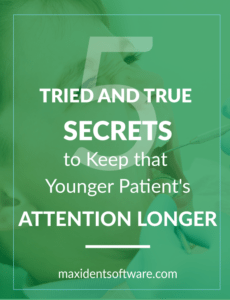I cannot stress enough just how important education is to your patient’s health and well-being. It is crucial that they are given the proper tools to maintain a healthy mouth even when they leave the office. But it is just as important to share your wisdom with your younger patients. However, children do not have a long attention span, and even if you are educating them with all they’ll need to know to make healthy choices at home, how can you be sure they are really listening and retaining the information?
As a kid, I remember when a few of the local dental professionals would come to our school and try to teach a crowded gymnasium the benefits of a healthy mouth. I also remember how most of us weren’t really listening. Some were distracted by someone else. Some were reading comic books, and some were daydreaming about being anywhere else. And if you think it’s going to be different on your turf, I guarantee you it won’t. A child’s attention span is short-lived and difficult to hold even on the best day. At one point in my career, I wanted to be a teacher and so had to learn to handle a short attention span and discover exactly what it takes to keep a child engaged. The following are five of my very own tried and true secrets to keep that younger patient’s attention longer.
-
Keep it fun
We’ve all been to an assembly meeting in the gymnasium before. If you haven’t, I will tell you right now, the magic ingredient to making those assemblies worth attending was a significant dose of entertainment with our education; “a spoonful of sugar helps the medicine go down.” To which Mary Poppins was not lying.
You can pull this off anyway you like. Put together a game show, provide a crossword or a word-find, incorporate hands-on activities. Add a little umph! to your voice and put together a presentation for the kids that will have them cheering and wanting more. Most people learn a lot more when they’re having fun, so don’t be afraid to get creative and think outside the box for fun ideas to implement into your patient education.
-
Keep it simple
No child is going to understand complicated terms or lengthy speeches filled with a bunch of “don’t do this or “don’t do that.” Kids do not respond well to complex and negative speeches. Keep it simple. And stay away from “don’t” as much as you can. They also do not respond well to an adult talking down to or at them. Talk to them. Make them feel comfortable and treat them like your equal. Who knows, they might even come back when they’re older with their kids and designate you as their family dental professional.
-
Keep it short
Length is hugely important when it comes to the attention span of children. Work with their short attention span by keeping your explanation short. The best thing to do is to be concise and come quickly to your point. It is best to gauge just how short your explanation needs to be by meeting and talking with the child and their parents first. Gather information and that way you will have an idea of just how much the child will retain before they fly off to Never-Never Land, leaving you and your attempts to effectively educate them, behind.
-
Keep it understandable
The one thing I noticed much of the time when working with children was their lack of patience and attention when it came to something they couldn’t understand. Some will ask, but some will just simply stop listening. Keep everything you say on a level they can understand, but don’t underestimate their understanding, either. There is only one way to know just what kind of intelligent mind you’re dealing with, and that’s by getting to know the child personally the way you would any other patient.
-
Keep it visual
Not all kids are visual learners, but you will find that most kids respond well to visual aids more so than just a strict speech. Be willing to think outside the box a little bit; however, make the images you do use kid-friendly and try to keep fear out of it. I know some dental professionals think this is an effective tactic in getting children to pay attention, but be warned that instead of trusting you and confiding in you, fear might just deter them from coming back.
Patient education is important to everyone, including the youngest in your office. The best way to provide your young patients with information they will fully understand and take home with them is to utilize out of the box thinking and make sure you align important education smoothly with your own personal brand of entertainment.
Do you want to know more?
I wrote another article about how to deal with young patients, just click here
And you can see all the articles about this subject clicking on the tag #youngpatients
Suggested Page:




